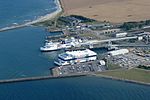Fehmarn: Difference between revisions
m Bot: Migrating 1 langlinks to WP:Wikidata - d:q3172 |
No edit summary |
||
| Line 42: | Line 42: | ||
==Nature== |
==Nature== |
||
The coasts serve as resting places for [[migratory bird]]s, and it is thus a |
The coasts serve as resting places for [[migratory bird]]s, and it is thus a popular location for [[ornithologist]]s. The islands bird reserves are looked after by [[NABU]]'s conservation centre at the [[Wallnau Waterbird Reserve]]. In Burg there is a large [[aquarium]] with 40 fish tanks. |
||
Fehmarn is famous for its nature and recreation areas, especially during summer times (July–September) and is also well known for its Windsurf and Kitesurf spots. Currently there are more than ten Surfspots known on the island. |
Fehmarn is famous for its nature and recreation areas, especially during summer times (July–September) and is also well known for its Windsurf and Kitesurf spots. Currently there are more than ten Surfspots known on the island. |
||
Revision as of 20:51, 27 March 2013
Fehmarn | |
|---|---|
 | |
| Country | Germany |
| State | Schleswig-Holstein |
| District | Ostholstein |
| Government | |
| • Mayor | Otto-Uwe Schmiedt |
| Area | |
| • Total | 185.45 km2 (71.60 sq mi) |
| Elevation | 10 m (30 ft) |
| Population (2022-12-31)[1] | |
| • Total | 13,247 |
| • Density | 71/km2 (190/sq mi) |
| Time zone | UTC+01:00 (CET) |
| • Summer (DST) | UTC+02:00 (CEST) |
| Postal codes | 23769 |
| Dialling codes | 04371 und 04372 |
| Vehicle registration | OH |
| Website | www.stadtfehmarn.de |
Fehmarn (Danish: Femern) is an island and—since 2003—a town on this island in the Baltic Sea, off the eastern coast of Schleswig-Holstein, Germany, and ca. 18 kilometers south of the Danish island of Lolland. It belongs to the district of Ostholstein.
History
Earlier names of the island are Femera, Fimbria, Cimbria parva, and Imbra.[2]
On 26 July 1932, the German Navy's training ship "Niobe" sank off the island during a sudden squall, with the loss of 69 lives. At Gammendorfer Strand on Fehmarn, within view of the site of the sinking, the Niobe-Denkmal monument was erected.
Since 1963, Fehmarn has been connected to the German mainland by a road and rail bridge crossing the Fehmarn Sound Bridge. It is 963.40 m (3160.76 ft.) long and 69 m high.
Geography
The area is 185 km² and the coastline is 78 km. The highest hills are the "Hinrichsberg" (27.2 m) and the "Wulfener Berg" (26.5 m). The largest community on Fehmarn is Burg, with 6,000 inhabitants. In addition, there are many small villages.
Transport
The Fehmarn Belt, a strait separating Fehmarn from Lolland, is located on the side opposite to Germany. It can be crossed by ferries travelling between the seaports of Puttgarden, Germany, and Rødbyhavn, Denmark. The crossing takes about 45 minutes.
On 29 June 2007, the Danish and German authorities gave the go-ahead for the Fehmarn Belt Fixed Link project, planned for completion in 2020.[3]
The 963-metre (3,159 ft) long Fehmarn Sound Bridge connects the German island of Fehmarn with the German mainland near Großenbrode.
Nature
The coasts serve as resting places for migratory birds, and it is thus a popular location for ornithologists. The islands bird reserves are looked after by NABU's conservation centre at the Wallnau Waterbird Reserve. In Burg there is a large aquarium with 40 fish tanks.
Fehmarn is famous for its nature and recreation areas, especially during summer times (July–September) and is also well known for its Windsurf and Kitesurf spots. Currently there are more than ten Surfspots known on the island.
Culture
Fehmarn was also the location of Jimi Hendrix's final concert, at the Open Air Love & Peace Festival, on September 6, 1970.
Notable residents
Lina Heydrich and her husband Reinhard Heydrich had a summer home here, which after the war Lina ran with her second husband Mauno Manninen, as a restaurant and inn until it burned down in February 1969.[4]
Twin towns
Gallery
-
Flügge lighthouse
-
Fehmarn Sound Bridge from the sound
-
Town hall in Burg
-
The seaport of Puttgarden
See also
References
- ^ "Bevölkerung der Gemeinden in Schleswig-Holstein 4. Quartal 2022" (XLS) (in German). Statistisches Amt für Hamburg und Schleswig-Holstein.
- ^ http://www.columbia.edu/acis/ets/Graesse/orblatf.html
- ^ http://www.femern.com/Home/Project/Timetable
- ^ Lehrer, Steven (2000). Wannsee House and the Holocaust. p. 196. ISBN 978-0-7864-0792-7.
External links
select an article title from: Wikisource:1911 Encyclopædia Britannica
- Satellite map from Google Maps
- Stadt Fehmarn
- Fehmarn Events
- Fehmarn Genealogy
 Reynolds, Francis J., ed. (1921). . Collier's New Encyclopedia. New York: P. F. Collier & Son Company.
Reynolds, Francis J., ed. (1921). . Collier's New Encyclopedia. New York: P. F. Collier & Son Company.







